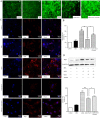Glucagon-like peptide-1 attenuates diabetes-associated osteoporosis in ZDF rat, possibly through the RAGE pathway
- PMID: 35581617
- PMCID: PMC9112483
- DOI: 10.1186/s12891-022-05396-5
Glucagon-like peptide-1 attenuates diabetes-associated osteoporosis in ZDF rat, possibly through the RAGE pathway
Abstract
Background: Diabetes-associated osteoporosis are partly caused by accumulation of advanced glycation endproducts (AGEs). Glucagon-like peptide-1 (GLP-1) has been shown to regulate bone turnover. Here we explore whether GLP-1 receptor agonist (GLP1RA) can have a beneficial effect on bone in diabetes by ameliorating AGEs.
Methods: In the present study, we evaluated the effects of the GLP-1 receptor agonist liraglutide, insulin and dipeptidyl peptidase-4 inhibitor saxagliptin on Zucker diabetic fatty rats. Meanwhile, we observed the effect of GLP-1 on AGEs-mediated osteoblast proliferation and differentiation and the signal pathway.
Results: Liraglutide prevented the deterioration of trabecular microarchitecture and enhanced bone strength. Moreover, it increased serum Alpl, Ocn and P1NP levels and decreased serum CTX. In vitro we confirmed that GLP-1 could attenuate AGEs-mediated damage in osteogenic proliferation and differentiation. Besides, GLP-1 down-regulated the ROS that caused by AGEs and the mRNA and protein expression of Rage .
Conclusions: Altogether, our findings suggest that GLP-1 receptor agonist promotes osteoblastogenesis and suppresses bone resorption on obese type 2 diabetic rats to a certain degree. The mechanism of these effects may be partly mediated by AGEs-RAGE-ROS pathway via the interaction with GLP-1 receptor.
Keywords: Advanced glycation endproducts; Diabetes; Glucagon-like peptide-1; Liraglutide; Osteoporosis.
© 2022. The Author(s).
Conflict of interest statement
The authors declare that the research was conducted in the absence of any commercial or financial relationships that could be construed as a potential conflict of interest.
Figures





Similar articles
-
Liraglutide improved the cognitive function of diabetic mice via the receptor of advanced glycation end products down-regulation.Aging (Albany NY). 2020 Nov 26;13(1):525-536. doi: 10.18632/aging.202162. Epub 2020 Nov 26. Aging (Albany NY). 2020. PMID: 33298623 Free PMC article.
-
Glucagon-like peptide-1 alleviates diabetic kidney disease through activation of autophagy by regulating AMP-activated protein kinase-mammalian target of rapamycin pathway.Am J Physiol Endocrinol Metab. 2020 Dec 1;319(6):E1019-E1030. doi: 10.1152/ajpendo.00195.2019. Epub 2020 Sep 28. Am J Physiol Endocrinol Metab. 2020. PMID: 32985256
-
Glucagon-like peptide-1 receptor signaling modifies the extent of diabetic kidney disease through dampening the receptor for advanced glycation end products-induced inflammation.Kidney Int. 2024 Jan;105(1):132-149. doi: 10.1016/j.kint.2023.09.029. Epub 2023 Dec 8. Kidney Int. 2024. PMID: 38069998
-
Cardiovascular Actions and Clinical Outcomes With Glucagon-Like Peptide-1 Receptor Agonists and Dipeptidyl Peptidase-4 Inhibitors.Circulation. 2017 Aug 29;136(9):849-870. doi: 10.1161/CIRCULATIONAHA.117.028136. Circulation. 2017. PMID: 28847797 Review.
-
Glucagon-Like Peptide-1 (GLP-1) Receptor Agonists in the Treatment of Obese Women with Polycystic Ovary Syndrome.Curr Vasc Pharmacol. 2017;15(3):218-229. doi: 10.2174/1570161114666161221115324. Curr Vasc Pharmacol. 2017. PMID: 28003008 Review.
Cited by
-
Semaglutide promotes the proliferation and osteogenic differentiation of bone-derived mesenchymal stem cells through activation of the Wnt/LRP5/β-catenin signaling pathway.Front Pharmacol. 2025 Mar 10;16:1539411. doi: 10.3389/fphar.2025.1539411. eCollection 2025. Front Pharmacol. 2025. PMID: 40129942 Free PMC article.
-
Gut hormones and bone homeostasis: potential therapeutic implications.Nat Rev Endocrinol. 2024 Sep;20(9):553-564. doi: 10.1038/s41574-024-01000-z. Epub 2024 Jun 10. Nat Rev Endocrinol. 2024. PMID: 38858581 Review.
-
Glucagon-like Peptide-1 Receptor Agonists and Diabetic Osteopathy: Another Positive Effect of Incretines? A 12 Months Longitudinal Study.Calcif Tissue Int. 2024 Aug;115(2):160-168. doi: 10.1007/s00223-024-01240-1. Epub 2024 Jun 12. Calcif Tissue Int. 2024. PMID: 38864922 Free PMC article.
-
The Beneficial Effects of GLP-1 Receptor Agonists Other than Their Anti-Diabetic and Anti-Obesity Properties.Medicina (Kaunas). 2024 Dec 26;61(1):17. doi: 10.3390/medicina61010017. Medicina (Kaunas). 2024. PMID: 39858999 Free PMC article. Review.
-
GLP-1 Agonists' Effect on Infection and Union after Tibiotalar Fusion, Subtalar Fusion, Triple Arthrodesis.Foot Ankle Int. 2025 Jun;46(6):617-621. doi: 10.1177/10711007251328370. Epub 2025 Mar 31. Foot Ankle Int. 2025. PMID: 40162958 Free PMC article.
References
MeSH terms
Substances
LinkOut - more resources
Full Text Sources
Medical
Miscellaneous

